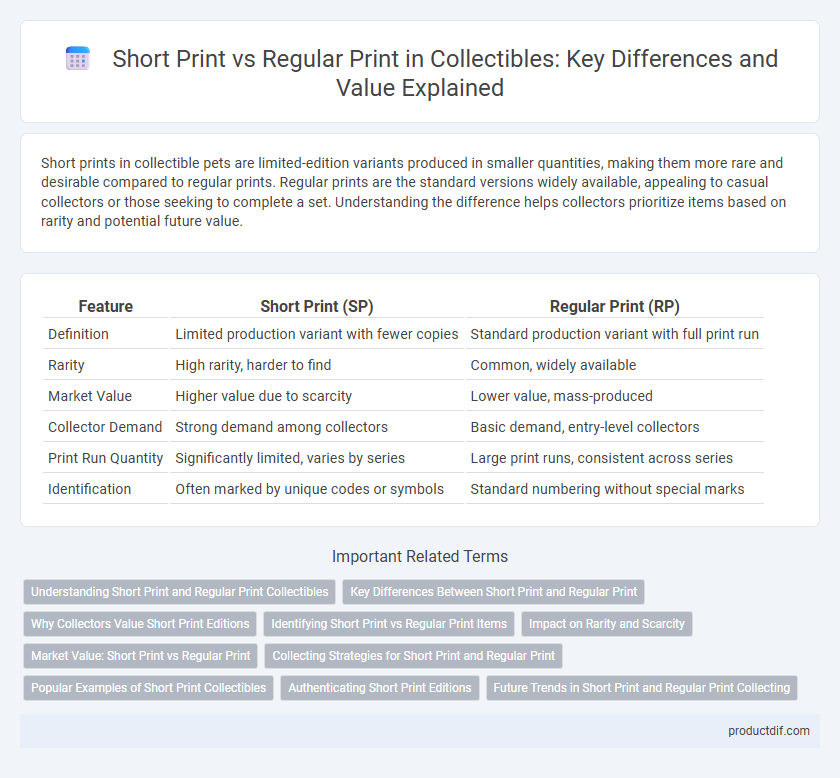Short prints in collectible pets are limited-edition variants produced in smaller quantities, making them more rare and desirable compared to regular prints. Regular prints are the standard versions widely available, appealing to casual collectors or those seeking to complete a set. Understanding the difference helps collectors prioritize items based on rarity and potential future value.
Table of Comparison
| Feature | Short Print (SP) | Regular Print (RP) |
|---|---|---|
| Definition | Limited production variant with fewer copies | Standard production variant with full print run |
| Rarity | High rarity, harder to find | Common, widely available |
| Market Value | Higher value due to scarcity | Lower value, mass-produced |
| Collector Demand | Strong demand among collectors | Basic demand, entry-level collectors |
| Print Run Quantity | Significantly limited, varies by series | Large print runs, consistent across series |
| Identification | Often marked by unique codes or symbols | Standard numbering without special marks |
Understanding Short Print and Regular Print Collectibles
Short print collectibles are limited edition items produced in smaller quantities compared to regular print versions, often making them rarer and more valuable to collectors. Regular print collectibles are mass-produced, ensuring wider availability but generally lower market value due to higher supply. Understanding the differences in print runs helps collectors identify scarcity, making informed decisions on investing in items with potential for appreciation.
Key Differences Between Short Print and Regular Print
Short print collectibles have a significantly lower production quantity compared to regular print items, making them rarer and often more valuable. Regular print items are mass-produced to meet general demand, whereas short prints are intentionally produced in limited numbers to create scarcity. Collectors prioritize short prints for their rarity and potential investment value, while regular prints provide broader accessibility and completeness to collections.
Why Collectors Value Short Print Editions
Collectors value short print editions because their limited availability significantly increases rarity and potential market value. These editions often feature unique artwork, variants, or exclusive content that distinguishes them from regular print runs. The scarcity drives demand, making short prints highly sought-after for investment and completion of collections.
Identifying Short Print vs Regular Print Items
Short print collectibles are produced in significantly smaller quantities than regular print items, making them rarer and often more valuable. Identifying short print items involves checking production numbers, release dates, and print run variations listed on official manufacturer sources or collector databases. Visual differences like unique markings, alternate artwork, or special edition logos also help distinguish short print from regular print collectibles.
Impact on Rarity and Scarcity
Short print collectibles have significantly lower production numbers than regular print versions, directly increasing their rarity and driving higher demand among collectors. The scarcity of short prints makes them more difficult to find, often resulting in premium market values compared to standard editions. This limited availability enhances their appeal as investment pieces within the collectibles market.
Market Value: Short Print vs Regular Print
Short print collectibles generally command higher market value due to their limited availability, making them more sought after by collectors and investors. Regular print versions, produced in larger quantities, tend to have lower scarcity and thus lower price points in comparison. Market demand heavily favors short prints, driving premiums that reflect their rarity and exclusivity.
Collecting Strategies for Short Print and Regular Print
Collectors often prioritize short print items due to their limited availability and potential for higher market value, focusing on securing rare editions through targeted purchases and timely acquisitions. Regular print collectibles are accumulated to complete baseline sets, emphasizing consistency and breadth rather than rarity, often relying on bulk buying and standardized pricing trends. Balancing both strategies enhances a diversified collection with both rarity-driven assets and foundational pieces.
Popular Examples of Short Print Collectibles
Short print collectibles, characterized by their limited production runs, often become highly sought-after due to their rarity and unique attributes. Popular examples include Topps baseball cards from certain years where star players like Derek Jeter or rookie cards were issued in significantly lower quantities than regular print versions. Funko Pop! figures also showcase short print variants, with exclusive editions or chase variants frequently fetching higher values among collectors.
Authenticating Short Print Editions
Authenticating short print editions requires careful examination of print run data and unique identifying markers, such as specific cover variations, barcodes, or edition numbering. Collectors must reference official publisher records and verified databases to distinguish short prints from regular prints accurately, ensuring the item's rarity and value. Expert authentication services and community-verified resources play a critical role in confirming the legitimacy of these limited production runs.
Future Trends in Short Print and Regular Print Collecting
Future trends in short print and regular print collecting indicate a growing demand for scarcity-driven items as collectors increasingly value rarity and exclusivity. Enhanced digital tools and blockchain technology are expected to improve authentication processes, boosting confidence in short print collectibles' provenance. Market analysis projects that short prints will command higher premiums due to limited availability, while regular prints maintain steady demand for entry-level collectors seeking more accessible investments.
Short Print vs Regular Print Infographic

 productdif.com
productdif.com